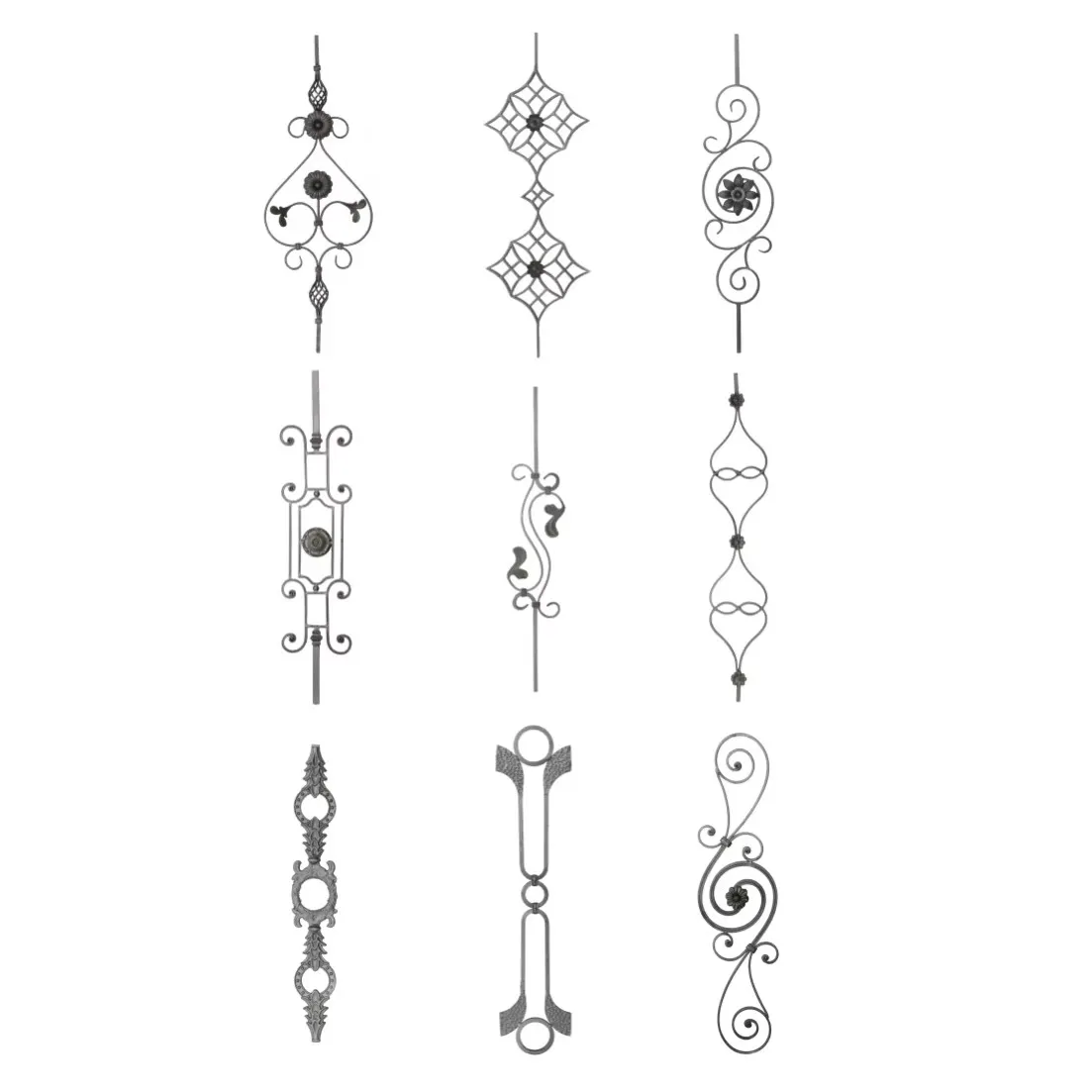
The Forged Wrought Iron Rosettes And Panels represent a new benchmark in the world of **rod iron fencing for sale**—offering heritage, strength, and architectural beauty for public/commercial sectors and high-end property applications. In this definitive guide, we comprehensively cover the latest industry trends, technical parameters, manufacturing flow, specification sheets, comparative tables, authoritative standards, tailored solutions, and real-world use cases, to empower your selection and investment decisions.
1. Industry Overview & Market Trends in Rod Iron Fencing For Sale
Over the past decade, sales of rod iron fencing for sale—including antique iron fence panels for sale and modern wrought iron fence panels—have grown due to resurgent demand for heritage aesthetics, increased security needs, and new manufacturing technologies.
According to IBISWorld, the US fencing market was valued at $8.3 billion (2023), with wrought iron holding over 18% share in premium fencing installations.
Internationally, rapid urbanization, demand for corrosion-resistant and ornamental metalwork especially in commercial, public, and high-value residential zones, drive robust growth across North America, Europe, and emerging Asian markets.

2. Technical Specifications Table: Types of Rod Iron Fencing For Sale
| Product Type | Main Material | Common Height (mm) | Panel Width (mm) | Panel Thickness (mm) | Finish | Design Lifespan (Years) | Certifications |
|---|---|---|---|---|---|---|---|
| Forged Wrought Iron Rosettes And Panels | Low-Carbon Steel/ Pure Iron | 900–2400 | 1000–2500 | 5–18 | Powder Coat/Hot-Dip Galv. | ≥40 | ISO 9001, ANSI, CE |
| Antique Iron Fence Panels For Sale | Pig Iron / Cast Iron Alloy | 900–2000 | 900–1800 | 8–25 | Handpaint / Patina | ≥60 | ASTM A123, EN 10244 |
| Wrought Iron Fence Panels | Wrought Steel (Low-Si) | 1000–2800 | 1400–3000 | 6–14 | Polyester Powder/ E-coat | 30–50 | ISO 12944, SGS |
3. Manufacturing Process: From Raw Material to Rod Iron Fencing For Sale

- Material Selection: Certified low-carbon steel or pure iron bars for forging, meeting strict ISO 9001 and ANSI specs for consistency.
- Forging & Shaping: Using induction forge presses (temperatures: 1000–1250°C) ensures exceptional grain integrity and impact toughness for panels and rosettes.
- Precision CNC Processing: Proprietary CNC tools cut intricate scrolls/ornamentation, guaranteeing tight tolerances (±0.5mm) for modular assembly compatibility.
- Surface Treatment: Hot-dip galvanizing, E-coat or advanced polyester powder coating grants >2,000h salt spray resistance and extreme UV protection. Industry-proven as per ISO 12944 and ASTM B117 standards.
- Inspection: 100% ultrasonic weld testing, impact/fatigue sampling, and batch mechanical property tests.
4. Product Spotlight: Forged Wrought Iron Rosettes And Panels
Technical Highlights
- Main Material: Low-carbon steel (Q235)/pure iron (Fe >99.5%)
- Panel Thickness: 5–18 mm (customizable)
- Finish: Hot-dip galvanized + polyester powder coating (≥80μm)
- Corrosion Resistance: > 2000h (Salt spray, per ASTM B117)
- Impact Strength: ≥350 J (Charpy V-notch at 20°C)
- Certifications: ISO 9001, ANSI, CE, SGS batch test
- Design Service Life: ≥40 years (industrial grade)
- Customization: Dimensions, pattern, rosette shape, post top, and color
Main Advantages
- Heritage Appearance: Classic scrolls & customized rosettes for architectural beauty
- Superior Physical Strength: Outclasses cast iron/fused steel by ≥25% in break resistance
- Corrosion Protection: Multi-layer surface finishing for marine/industrial exposure
- Low Maintenance: No repainting needed for 10–15 years
- Eco-friendly: 95% recyclability and low-VOC finishes
5. Product Comparison: Forged Wrought Iron Rosettes And Panels vs. Alternatives
6. Data Visualization: Market Share for Rod Iron & Wrought Iron Fence Types (Global, 2023)
7. Typical Applications & Use Case Analysis
Public & Urban Infrastructure
- Perimeter and security fencing for government, flagship retail, airports
- Heritage district restoration (museum, park, school fences)
- Courthouse, embassy, and civic building boundary fencing
High-End Residential & Commercial
- Custom estate boundaries with ornamental rosettes and scrollwork
- Gated community entrances, exclusive clubs, and hotels
Heavy Industry & Utilities
- Petrochemical plants and waterworks (anti-corrosion perimeter fencing)
- Transformer/power substations (UL/CE certified anti-climb fence panels)
- Steel mills, mining, and port premises—long-lifespan protection
Real Use Case - Municipal Park Renovation, EU
- Challenge: Coastal air, high vandalism risk, historic look required
- Solution: Forged Wrought Iron Rosettes And Panels (7mm, HDG + powder, 2.1km supplied)
- Result: No visible corrosion/paint loss after 5+ years, zero theft/vandal damage
Client Feedback Highlights
- “Quick lead time, perfect match for neoclassical church restoration.” - Architect, UK
- “Panel fit-out was easier than with cast iron; cost-effective over 30 years!” - Municipal engineer, Canada
8. Why Choose Our Rod Iron Fencing For Sale (Forged Wrought Iron Rosettes And Panels)?
- Certified Expertise: Production in ISO 9001 and CE compliant facility, with ANSI welding standards. Decades of export experience with public, industrial, and heritage renovation tenders.
- Custom Project Support: Rapid 3D CAD design & rendering, custom sizing, color/pattern selection, and modular accessories for gates/posts.
- Full Traceability: Mill test, batch number, and inspection reports delivered with every order.
- Environmental & Occupational Compliance: Low-VOC finishes, zero hazardous hexavalent chromium, 95% recycled steel content, meets RoHS and REACH standards.
- Industry References: Major projects in public infrastructure, utilities, and luxury residential on three continents.
9. Delivery, Warranty & Client Support
- Delivery Time: Standard: 30 days (FCL); Expedited: 15 days (depending on volume and customization)
- Packaging: Steel crating, anti-corrosive wraps, 100% barcode tracking
- Warranty: 10-year anti-corrosion coating guarantee; weld joint replacement up to 24 months
- After-Sales Support: Email, WhatsApp, WeChat or phone, full technical consultation for installation, maintenance, and compliance
- Documentation: Installation manual (EN, FR, ES/CN on request), 3D layout support, foundation drawings
- Spare Parts & Accessories: Posts, gates, latches, ornament repair kits available
- Every batch receives full mechanical, salt-spray, and dimensional compliance testing
- Certificates: ISO 9001, ANSI, SGS, Third-party witness accepted
10. FAQ: Professional Questions on Rod Iron & Wrought Iron Fence Panels
Frequently Asked Questions about Rod Iron Fencing For Sale Specifications, Usage, and Standards
-
Q1. What is the difference between "rod iron," "wrought iron," and "cast iron" in fencing applications?
A1. Rod iron typically refers to a pure iron product rolled into bars. Wrought iron denotes iron worked (forged/rolled) by hand or machine for greater ductility. Cast iron is poured in molten state, yielding lower ductility but higher wear resistance. For fencing, forged wrought iron combines high impact resistance (≥350J) with long service life. -
Q2. What are the typical panel dimensions and can they be customized?
A2. Standard heights: 900–2400mm; width: 1000–2500mm; thickness: 5–18mm. All can be customized per project, including ornamental pattern, color, rosettes, and top elements. -
Q3. Which standards/certifications does your forged iron fence satisfy?
A3. Certified to ISO 9001 (quality management), ANSI (welding/process), CE (Europe), and batch-tested with ASTM B117 salt spray and ISO 12944 corrosion exposure. Third-party inspection available on request. -
Q4. Is there minimum order quantity (MOQ) for rod iron fencing for sale?
A4. Flexible—standard MOQ 60 meters (approx. 10–24 panels), with large project or restoration orders supported. Small sample panels and rosette elements available for architects/designers. -
Q5. What is the typical install method and which anchoring standards are used?
A5. Options: Bolted or grouted post footings (as per EN 1991, ACI 318 standards); welded assemblies for custom gates. Foundation drawings and installation manuals are provided for all shipments. -
Q6. How is long-term corrosion resistance achieved?
A6. Combination of hot-dip galvanizing and advanced powder/polyester coatings, achieving ≥2000h neutral salt spray resistance. Base metal selection/pre-treatment is strictly monitored under ISO 12944. -
Q7. Are there any specific maintenance requirements?
A7. Minimal—visual inspection every 2–3 years; light cleaning only. Recoating intervals (if needed) are typically 15–25 years, depending on environment.
11. How to Order & Customization Process
- Contact our technical team via Official Product Page or email for preliminary requirements and CAD drawings.
- We will deliver a tailored proposal with specifications, price quotation, delivery timeline, and supporting samples (upon request).
- Upon approval, production begins; regular status updates & quality inspection reports sent throughout the process.
- On-site technical support, and optional installation guide, are available for large contracts or specialty designs.
References & Further Reading
- IBISWorld – Fence Construction Industry Statistics 2023
- ASTM B117 – Standard Practice for Operating Salt Spray (Fog) Apparatus
- ISO 12944 – Corrosion Protection of Steel Structures by Protective Paint Systems
- FenceForum: Wrought Iron vs Aluminum vs Steel Panel Discussion
- Forged Wrought Iron Rosettes And Panels Official Page
-
Unique Design Ideas for Wrought Iron Wall DecorNewsJul.21,2025
-
Stainless Steel Pulley for Marine ApplicationsNewsJul.21,2025
-
Safety Features in Industrial Track PulleyNewsJul.21,2025
-
Precision Tolerances for 2 Inch U Groove WheelsNewsJul.21,2025
-
Iron Fence Spears Corrosion Protection MethodsNewsJul.21,2025
-
Iron Decorative Panels for Balcony ScreensNewsJul.21,2025
-
Industrial Applications Requiring Heavy Duty PulleyNewsJul.21,2025












